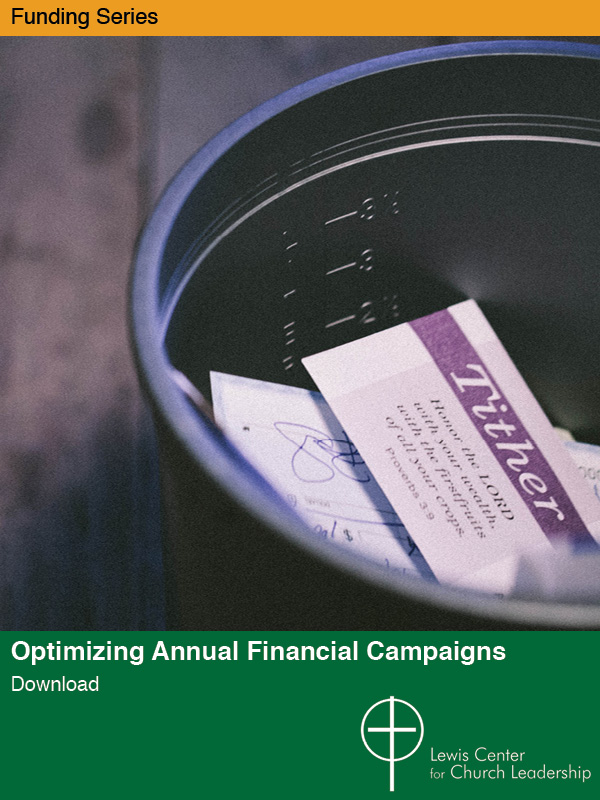Church members who make pledges give substantially more than those who do not, and congregations that seek annual financial commitments have significantly higher levels of overall giving. These 50 tips will help you maximize giving by improving your annual financial campaign.
Engage your leaders and members
- Choose a time of year when the congregation can focus its attention on stewardship and when there is a high probability of connecting with the most people. The annual financial campaign should be on the calendar a year in advance and planned with as much attention to detail as Easter Sunday and Christmas Eve.
- Pick a new theme every year for your stewardship campaign. Taking the time to be creative and innovative may encourage your members to take the time to reflect on their giving.
- Be strategic in building a leadership team. Involve a large group of people to build their sense of responsibility for the outcome. Include persons from different age groups and different ministry areas. A faithful giver (preferably someone who tithes) should head your annual stewardship campaign.
- Be sure that the generous givers of the congregation are well represented on the stewardship team and other groups related to the church’s funding, just as you would be sure to include those most active in other ministry areas as you plan for those ministries.
- Do not hesitate to ask church leaders to make their pledges first as a sign of their commitment and as an encouragement to the larger congregation.
- Orchestrate a comprehensive communication strategy to focus attention on stewardship during your campaign. Use every available means — sermons, music, testimony, newsletter articles, study programs, bulletin boards, banners, etc.
Plan carefully
- Remember — and communicate — that the annual budget is about ministry and mission, not dollars. Prepare the budget with great care, being sensitive to giving trends. Set ambitious but realistic goals.
- Define your purpose and set goals. Set priorities and sequence activities in appropriate ways. Be efficient and realistic in making assignments. Be logical about how you allocate your time and efforts in relation to expected outcomes.
- Establish a realistic timeline. In larger churches, planning and implementing the annual commitment campaign can take six months or more. Use benchmark dates to keep on track.
- Avoid the temptation to rush to the final steps without spending adequate time and attention on the foundational steps that normally determine success or failure.
- Know that developing a congregation of faithful givers does not happen only through a stewardship drive. Develop a year-round approach to stewardship education.
- Appreciate that fund raising is incremental. The most important determinant of how much you can raise this year is what you raised last year.
Approach solicitation with a healthy frame of mind
- Never be apologetic or feel guilty about stewardship appeals. Campaign leaders are not asking for themselves. Their willingness to approach others about giving is an expression of their deep commitment to the church. The vast majority of those being asked will respond in ways that honor that commitment.
- Remember that there is a great deal of “money looking for mission” and that many people are seeking ways to use their resources to advance their values and do God’s will.
- Remember that people give to many things, so do not assume that people will give all their charitable giving to the church. You need to make your case.
- Emphasize that stewardship is about faithfulness to God, not obligation to the church. Stress the giver’s joy in giving rather than the church’s need to receive.
Structure your campaign to acknowledge unique giving patterns
- Know that every church has a “giving pyramid” with a small percentage of donors contributing a large proportion of what is given; for not all people have the same resources to give, and not all people are at the same level of spiritual maturity. Most money will come from larger gifts.
- Analyze giving histories and membership data in your congregation to determine where your people are on your pyramid.
- Track pledges and giving by age “decades” (younger than 20s, 20s, 30s, 40s, etc.) so you can assess giving patterns across age groups.
- Determine what percentage of giving comes from those aged 70 and above. You may be vulnerable if this percentage is high and getting higher each year.
- Focus on those currently giving. Most of the giving, including increases, will come from those already giving.
- Be realistic in your expectations from those who are not currently giving. New donors are much more difficult to reach, are less likely to respond, and will give less than those already giving.
- Know that one approach will not fit everyone in the church. What is appropriate for the spiritually mature member who demonstrates faithfulness may not be appropriate for a newer or relatively inactive member who has never given. Think of relating to people “as they have lifted their hands.”
- Think in terms of “concentric circles” with your committed core (active members who are strong givers) in the center.
- Expand the circles, then, to includes actives who are likely to move up in giving because of their income, level of engagement, and current giving; new members since last year; those who attend or participate but do not give; and inactives who do not participate or give.
- Have multiple goals with these realities in mind — a comprehensive effort that invites everyone to give along with a focused effort on the relatively few likely to give the most. Seek to increase the number of pledgers and to increase the giving of those who already give.
- Set giving targets to help people get a figure in mind. People normally do not give more than they are asked. Set different giving ranges for different categories of givers.
- Provide a “Step Up” plan to encourage everyone to grow in giving.
- Make each part of the plan as personal as possible and appropriate.
Know what motivates people to give
- Know that people give from a mixture of motives. Few give out of a clear spiritual rationale. Most do not have a well-planned or consistent approach to giving.
- People will “protect themselves.” You do not need to guard them against over-giving!
- Appreciate that people want care in the use of their money, but procedures and documentation do not tend to be motivators for giving except in the negative.
- Remember that people are likely to continue giving once they begin.
- Nurture relationships. People give based more on credibility and relationships than on the merits of the cause.
Ask in effective ways
- Take the initiative. If you want money, you must ask for it. Many never give because they were never asked nor given compelling reasons to do so.
- Use the most personal approach possible. A personalized letter is better than a form letter, a hand-written note better than a letter, a phone call better than a note. A one-on-one visit is best of all! If you cannot visit everyone, start at the top of your pyramid.
- Be positive in everything you communicate about giving. Eliminate negative references.
- Never divide the budget by the number of church families or members and say, “If everyone gave just …” Those who give little will not give more, but some who give more may give less
- Most people do not give to support budgets. They give to support people and programs.
- Build your message around mission. Relate everything to the church’s vision and purpose.
- Prepare a “Ministry Impact Budget” to use in your campaign. Rather than presenting “line items,” this budget should interpret ministry and mission in ways that are meaningful to your membership (worship ministries, educational ministries, outreach ministries, etc.).
- Always, however, make the accounting version available to anyone requesting it.
- Use groups in your church to reinforce your campaign efforts. Prepare group study materials related to your campaign theme. Ask group leaders to help in contacting their members.
- Know that congregations that seek annual pledges have a higher level of giving than congregations that do not ask for annual commitments.
- Make giving by automatic withdrawal simple to choose when people make their pledges.
- In all pledge requests, acknowledge that some may be in a “financial jam.” Ask them to commit what they can and not to let their inability to give more keep them from church.
Follow-up
- Do not think of a Commitment Sunday as the end of the campaign. It is an important celebration and punctuation point, but much work needs to happen after that day to reach those who have not responded.
- Follow every successful solicitation with a meaningful gesture of appreciation.
- Do not forget to seek commitments between campaign periods, especially from new members.
- Be sensitive to members’ desire and need to make year-end gifts. Communicate any deadlines for year-end giving positively, focusing on all the ways a person can give in a hectic time of the year. Do not make it hard for people to give.
 Download a PDF of this page to share with others.
Download a PDF of this page to share with others.
Learn How to Make Your Annual Financial Campaign More Effective
Save $10 on Optimizing Annual Financial Campaigns plus all other funding and stewardship video tool kit resources through September 30, 2024.
Church members who pledge give 30 percent more than those who do not, and congregations that seek annual financial commitments have significantly higher levels of overall giving. With Optimizing Annual Financial Campaigns you will learn to reap the harvest of generosity through best practices to make your annual financial campaign more effective. The resource includes video presentations, written materials, and supplemental materials. Learn more now.





